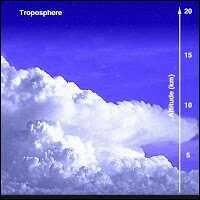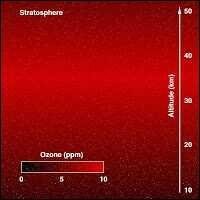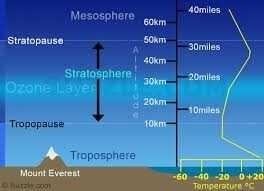LAYER OF ATMOSPHERE IN THE SKY
LAPISAN ATMOSFER YANG ADA DI LANGIT
1) Lapisan Troposfer
Lapisan ini merupakan lapisan yang paling bawah, berada antara permukaan bumi sampai pada ketinggian 8 km pada posisi kutub dan 18 – 19 km pada daerah ekuator. Pada lapisan ini suhu udara akan menurun dengan bertambahnya ketinggian. Setiap kenaikan 100 meter temperaturnya turun turun 0,5 oC. Lapisan ini dianggap sebagai bagian atmosfer yang paling penting, karena berhubungan langsung dengan permukaan bumi yang merupakan habitat dari berbagai jenis mahluk hidup termasuk manusia, serta karena sebagain besar dinamika iklim berlangsung pada lapisan troposfer.
Susunan kimia udara troposfer terdiri dari 78,03% nitrogrn, 20,99 oksigen, 0,93% argon, 0,03% asam arang, 0,0015% nenon, 0,00015% helium, 0,0001% kripton, 0,00005% hidrogen, serta 0,000005%xenon.
Di dalam lapisan ini berlangsung semua hal yang berhubungan dengan iklim. Walaupun troposfer hanya menempati sebagian kecil saja dari atmosfer dalam, akan tetapi, 90% dari semua masa atmosfer berkumpul pada lapisan ini. Di lapisan inilah terbentuknya awan, jatuhnya hujan, salju, hujan es dan lain-lain.
Di dalam troposfer terdapat tiga jenis awan, yaitu awan rendah (cumulus), yang tingginya antara 0 – 2 km; awan pertengahan (alto cumulus lenticularis), tingginya antara 2 – 6 km; serta awan tinggi (cirrus) yang tingginya antara 6 – 12 km.
The troposphere is subdivided into four layers:
a. Basic Air Layer
The thickness of this air layer is 1 - 2 meters above the earth's surface. Circumstances in this air layer depend on the physical condition of the earth's surface, of the type of plant, the height of the sea surface and others. Air condition in this layer is called a microclimate, which affects the life of plants and also the living body in the soil.
b. Lower Air Layer
This layer of air is also called planetary boundaries (planetary grenslag, planetary boundary layer). Thickness of this layer 1 - 2 km. Here the air temperature changes take place and also determine the climate.
c. Air Advection Layer (Horizontal Movement)
This layer is also called convection air layer or cloud layer, which is 2 - 8 km thick. In this air layer the horizontal movement is larger than the upright movement. The heat and cold that collide here result in a variable temperature condition.
d. Tropopouse Air Layer
Is a transition layer between the troposphere layer and the stratosphere lies between 8 - 12 km above sea level (asl). In this layer there is the lowest degree of heat, ie between - 46 ° C to - 80 ° C in summer and between - 57 ° C to - 83 ° C in winter. Very low temperatures in the tropopouse cause water vapor can not penetrate into higher atmospheric layers, since water vapor is condensed before it reaches the tropopouse and then falls back into the earth in the form of liquid (rain) and solid (snow, hail) .
2)Stratosphere layer
It is part of the atmosphere above the troposphere to an altitude of 50-60 km, or rather it lies between the troposphere and the ionosphere.
In the stratosphere layer, the temperature will increase with increasing height. The temperature at the top of the stratosphere is almost the same as the temperature on the earth's surface. Thus, the temperature profile of the stratosphere layer is the opposite of the troposphere layer.
An important feature of the stratospheric layer is the presence of an ozone layer that is useful for absorbing ultraviolet radiation, so that most will not reach the Earth's surface.
The absorption of solar radiation by ozone and some other atmospheric gases causes the air temperature in the stratosphere to rise. The stratospheric layer contains no moisture, so this layer contains only dry air. The boundary layer of the stratosphere is called the stratopouse.
The stratosphere layer is divided into three parts:
a. Isotherm air layer; located between 12 - 35 km above sea level, with air temperature - 50 ° C to -55 ° C.
b. Hot air layer; located between 35 - 50 km above sea level, with temperatures - 50 ° C to + 50 ° C.
c. Top mixed air layer; located between 50 - 80 km above sea level, with temperatures between + 50 ° C to -70 ° C due to the influence of ultraviolet light, at a height of 30 km oxygen is converted to ozone, until the levels rise from 5 to 9 x 10-2 cc inside 1 m3.
3) Mesosphere layer
The mesosphere lies above the stratosphere at an altitude of 50 - 70 km. The temperature in this layer will decrease with increasing height. The temperature first rises, but then drops and reaches -72 ° C at a height of 75 km.
The lowest temperature is measured at an altitude between 80-100 km which is the boundary with the next atmospheric layer, ie the mesosphere layer. The transition region between the mesosphere and thermosphere layers is called the mesopouse with the lowest temperature - 110 ° C.
4. Thermosphere
Termospheric Layer Being above the mesopouse with a height of about 75 km to a height of about 650 km. In this layer, the gases will be ionized, therefore this layer is often referred to as the ionosphere layer. Oxygen molecules will split into atomic oxygen here.
The process of breaking up the oxygen molecules and other atmospheric gases will produce heat, which will cause an increase in temperature in this layer. The temperature in this layer will increase with increasing altitude. The ionosphere is divided into three more layers:
a. Air Layer E
Located between 80 - 150 km with an average of 100 km above sea level. This layer is where the highest ionization process occurs. This layer is also called KENNELY and HEAVISIDE air layer and has reflective properties of radio waves. Suu air here ranges from - 70 ° C to + 50 ° C.
b. Air layer F
Located between 150 - 400 km. This layer is also called APPLETON air layer.
c. The atomic air layer
In this layer, objects are in atomic form. The location of this layer between 400 - 800 km. This layer receives heat directly from the sun, and it is thought to reach 1200 ° C.
5. Ecosphere layer Is the highest layer of the atmosphere. In this layer, the atmospheric gases are very low. The boundary between the ecosphere (which is also essentially the boundary of the atmosphere) with outer space is unclear.
Areas that still include the ecosphere is an area that can still be affected by the earth's gravitational power. An imaginary line that limits the ecosphere to outer space is called a magnetopause.
Link source
By@fadliestem





Hello! I find your post valuable for the wafrica community! Thanks for the great post! @wafrica is now following you! ALWAYs follow @wafrica and use the wafrica tag!